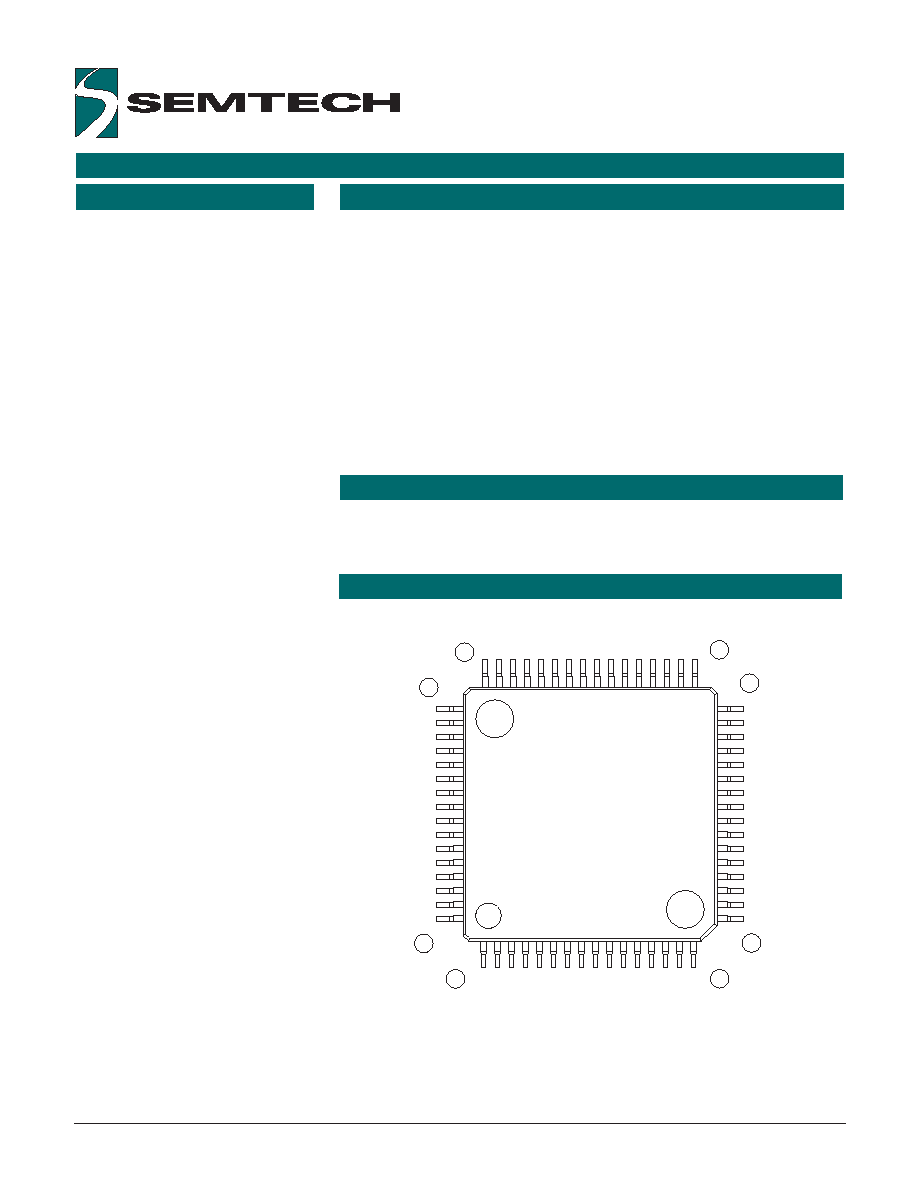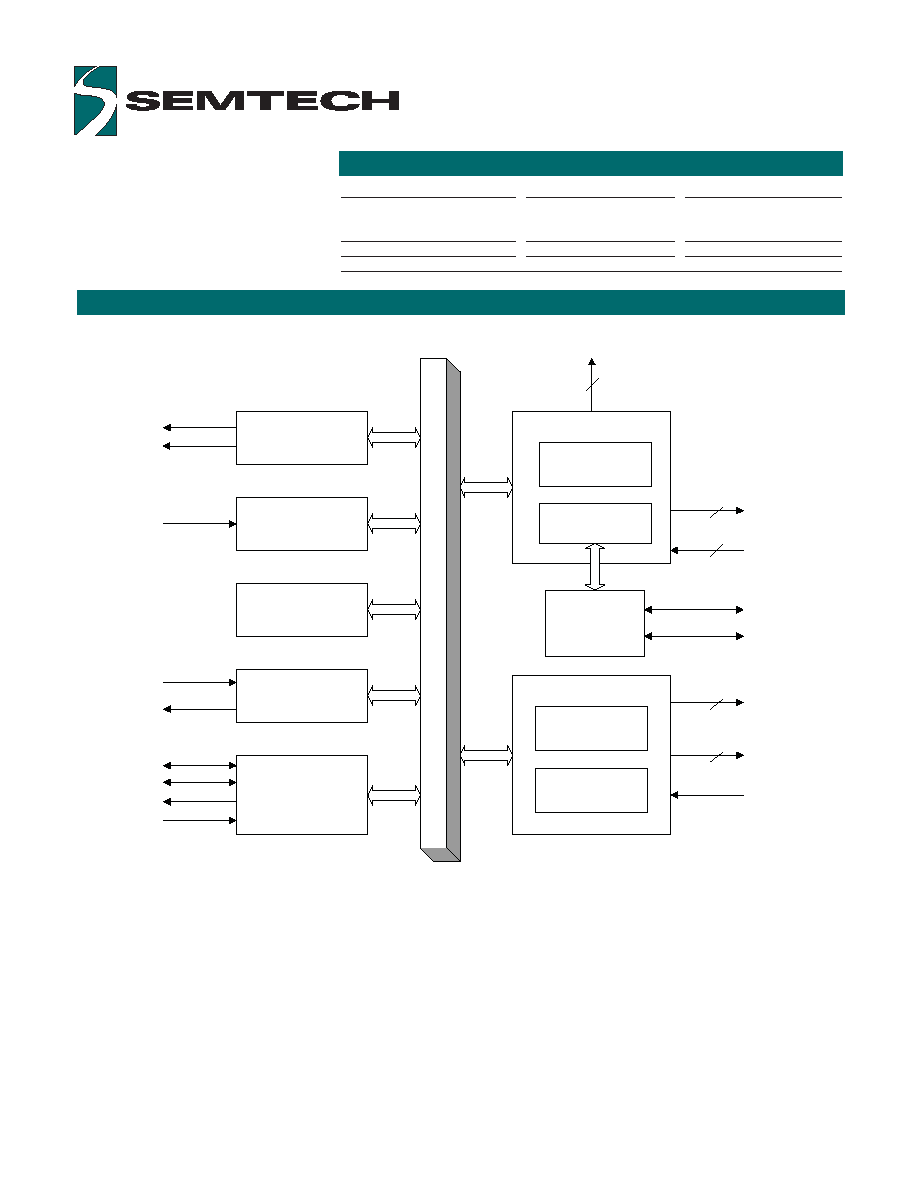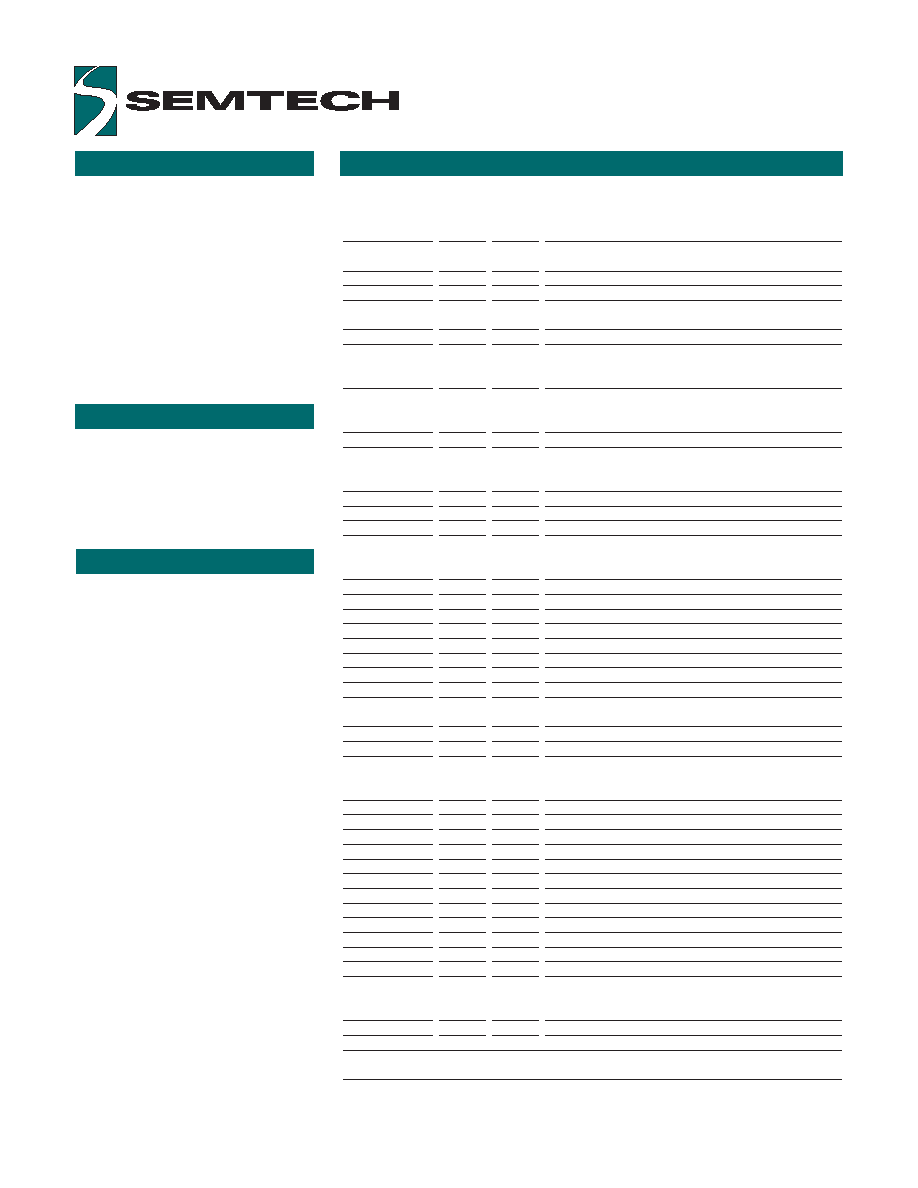 | ÐлекÑÑоннÑй компоненÑ: SH2165 | СкаÑаÑÑ:  PDF PDF  ZIP ZIP |
SH2165 PixiKey data sheet

Semtech, the Semtech logo, PixiKey, PixiPoint,
and KeyCoder are marks of Semtech Corporation.
Windows is a mark of Microsoft Corporation. I2C
is a mark of Philips Semiconductors Corporation.
PS/2 is a mark of IBM Corporation. All other
marks belong to their respective owners.
Copyright ©1999-2005 Semtech Corporation
SH2165 data sheet v1.08 (2005-05-17)
www.semtech.com
1
SH2165 PixiKeyTM
Programmable Keyboard Encoder
& Force Stick Encoder
HID & SYSTEM MANAGEMENT PRODUCTS, KEYCODER® FAMILY
DESCRIPTION
FEATURES
· Industrial keyboards
· Point-of-sale (POS) terminals
· Notebook PCs
· Portable devices
· Accessories
· Embedded keyboards
The SH2165 PixiKeyTM is a cost-
effective, high-functionality
combination keyboard and mouse
encoder which offers a
programmable keyboard matrix and
a PixiPoint® strain gauge sensor
interface. It is a USB 2.0 full-speed
device. The SH2165 is ideal for
industrial applications.
The SH2165 scans and encodes
an 8-row by 18-column keyboard
matrix. The encoder retrieves
matrix information from built-in
ROM or a separate serial
EEPROM. Semtech provides
Windows® applications to create
the binary matrix file, and to upload
the matrix to the EEPROM.
The SH2165 PixiKey interfaces
various strain gauge pointing
device sensors.
Typically consuming about 10 mA,
the SH2165 PixiKey is ideal for
battery-operated systems. The IC
supports USB "Selective Suspend"
that allows host system to enter
power saving mode.
· Provides direct drive for four LEDs
(caps lock, numeric lock, scroll
lock, katakana)
· Advanced motion control algorithm
provides accurate cursor control
· Provides built-in profiles to
interface popular force-stick
sensors from several
manufacturers
· 3.0 V 3.6 V operation over
extended temperature range
· Low power consumption: 10 mA
(typical)
· 64-pin LQFP package
· USB 2.0 full-speed HID keyboard
and mouse combo device
· Works with standard Windows
keyboard and mouse drivers
· Bootable USB keyboard device
· Bootable USB mouse device
· Programmable 8 x 18 keyboard
matrix
· Multimedia key support
· Windows applications provided to
design and load keyboard matrix
· Up to 22 custom / macro keys
APPLICATIONS
PIN ASSIGNMENTS
1
64
49
16
17
32
33
48
ROW6
ROW7
BKLTON
BKLT50
COL13
COL14
COL15
SELA
SELB
SELC
COL16
COL17
DRVM
DRVP
XYNOTZ
CLAMP
COL03
COL02
COL01
COL00
SDA
SCL
D-
D+
TrON
USBVref
DVcc
PVcc
PVss
NUMLED
CAPSLED
SCRLLED
CCLAMP
DAP
DAN
AD
RDRV
ZSENS
CNVss
_RESET
VccE
Vref
Vss
Xin
Xout
Vcc
Vss2
KANALED
ROW5
ROW4
ROW3
ROW2
ROW1
ROW0
COL12
COL11
COL10
COL09
COL08
COL07
COL06
FNMOD
COL05
COL04
SH2165-FGT

SH2165
ORDERING CODE
Copyright ©1999-2005 Semtech Corporation
SH2165 data sheet v1.08 (2005-05-17)
www.semtech.com
2
Package Options
Pitch
T
A
= -20° C to +85° C
64-pin LQFP
0.5mm
SH2165-FGT
Lead free, fully RoHS and
WEEE compliant
Evaluation kit
SH2165-EVK
Backlight
Control
Power On Reset
16 Bit Timer
Oscillator Circuit
Keyboard Interface
Keyboard Matrix
LED Interface
I2C Interface to
EEPROM
USB 2.0 Full Speed
Interface
PixiPoint Interface
X, Y, Z, Switch
Input
Control
18
Columns
8
Rows
LED drive lines
4
9
Drive Pins
AD Input
Select Pins
3
XIN
XOUT
D-
D+
TrOn
USBVref
_RESET
SCL
SDA
BKLTON
BKLT50
BLOCK DIAGRAM FOR THE SH2165 PIXIKEY

SH2165
Copyright ©1999-2005 Semtech Corporation
SH2165 data sheet v1.08 (2005-05-17)
www.semtech.com
3
DESCRIPTION
PIN DESCRIPTIONS
The SH2165 consists functionally
of several major sections (see the
block diagram on the previous
page). These include the PixiPoint
interface, the keyboard interface,
the 16-bit timer, the oscillator
circuit, the USB 2.0 full-speed
communication port, and the I2C®
EEPROM communication port. All
sections communicate with each
other and operate concurrently.
The SH2165 has a built-in
oscillator circuit intended to work
with an external 6.00 MHz crystal
or ceramic resonator with built-in
load capacitors.
OSCILLATOR
If an EEPROM is used, it must be
an industry standard 32-Kbit or
larger EEPROM, such as a
24LC32; the I2C serial data and
serial clock pins must be connected
to it.
EEPROM SERIAL INTERFACE
Mnemonic
Pin
Type
Name and Function
Power
Vcc
14
P
Power supply: 3.0 V 3.6 V
VccE
9
P
Connect to Vcc
DVcc, PVcc
22, 21
Vref
10
P
Reference voltage; connect to Vcc
Vss
11
P
Ground
CNVss, Vss2
7, 11
P
Connect to Vss
PVss
20
Vref
10
P
Reference voltage; connect to Vcc
Reset
_RESET
8
I
Reset
Oscillator
Xin
12
I
Oscillator Input
Xout
13
O
Oscillator Output
USB
D-
26
I/O
USB D- line
D+
25
I/O
USB D+ line
TrON
24
O
USB reference voltage output
USBVref
23
P
USB reference voltage input; connect to Vcc
Keyboard
CAPSLED
18
I/O
Caps lock LED: direct drive pin
KANALED
16
I/O
Katakana LED/emergency LED: direct drive pin
NUMLED
19
I/O
Num lock LED: direct drive pin
SCRLLED
17
I/O
Scroll lock LED: direct drive pin
COL00-05
29-34
I/O
Columns for scan matrix
COL06-12
36-42
I/O
Columns for scan matrix
COL13-15
53-55
I/O
Columns for scan matrix
COL16-17
59-60
I/O
Columns for scan matrix
ROW0-7
43-50
I/O
Row lines for scan matrix
FNMOD
35
I/O
Function operation mode: simple mode: tie to ground;
sticky mode: leave floating
BKLT50
52
I/O
Backlight control (leave floating if no backlight used)
BKLTON
51
I/O
Backlight control (leave floating if no backlight used)
Pointer
SELA
56
I/O
PixiPoint mux select A
SELB
57
I/O
PixiPoint mux select B
SELC
58
I/O
PixiPoint mux select C
AD
4
I/O
Analog to digital converter pin
CCLAMP
1
I/O
Sample capacitor minus drive
CLAMP
64
I/O
Sample capacitor plus drive
DAN
3
I/O
Reference resistor minus drive
DAP
2
I/O
Reference resistor plus drive
RDRV
5
I/O
Integration drive
DRVM
61
I/O
Positive drive
DRVP
62
I/O
Negative drive
XYNOTZ
63
I/O
High: XY drive; low: Z drive
ZSENS
6
I
Z sensitivity setting
I2C
SCL
27
I/O
I2C serial clock to and from matrix EEPROM
SDA
28
I/O
I2C serial data to and from matrix EEPROM
Note:
An underscore before a pin mnemonic denotes an active low signal.
Pin Types Legend:
I=Input; O=Output; I/O=Input or Output; P=Power

SH2165
USB POWER MANAGEMENT
Copyright ©1999-2005 Semtech Corporation
SH2165 data sheet v1.08 (2005-05-17)
www.semtech.com
4
The SH2165 supports the USB suspend command and remote wake-up
feature. In suspend state, the SH2165 still runs normally, consuming about
5 mA, because the PixiPoint sampling circuit must run continuously. This
does not comply with the USB specification, which requires power
consumption under 500 µA when suspended. But the host system can still
put the USB hub and other related circuits into low power consumption
mode. When the SH2165 gets any keyboard report or PixiPoint report, it
wakes up the host.
Windows® XP supports "selective suspend", which works very well with
SH2165. But Windows XP does not normally turn on "selective suspend"
for a composite device like the SH2165. Semtech provides a driver
initialization file (smtchid.inf) to enable "selective suspend" for the SH2165
under Windows XP. To enable "selective suspend" for the SH2165 under
Windows XP, take the following steps:
1. Connect the SH2165 to the host system.
2. Go to Windows Control Panel > System > Hardware Manager
3. Under Human Interface Devices, you see two USB Human Interface
Devices, one for the SH2165 keyboard and one for the SH2165 mouse
(force stick). Follow step 4 for each item.
4. Right-click the item, choose update the driver manually and choose
"have disk." Then select the smychid.inf file.
Note:
Semtech does not and need not provide drivers. Semtech provides
this driver initialization file so that the selective suspend feature is
supported for the SH2165, using the existing Microsoft mouse and
keyboard drivers.

SH2165
SMTCHID.INF LISTING
Copyright ©1999-2005 Semtech Corporation
SH2165 data sheet v1.08 (2005-05-17)
www.semtech.com
5
; Copyright (c) 1999-2004 Semtech
;
; smtchid.inf
;
[Version]
Signature="$WINDOWS NT$"
Class=HIDClass
ClassGuid={745a17a0-74d3-11d0-b6fe-00a0c90f57da}
Provider=%SMTC%
CatalogFile=smtchid.cat
DriverVer=05/07/2003,1.0.0.0
;[SourceDisksNames]
;1=%DiskDescription%,"",,
;[SourceDisksFiles]
; No files are installed by this INF
[Manufacturer]
%SMTC%=SMTC_HID
[SMTC_HID]
;
%USB\VID_047A&PID_0004.DeviceDesc%=SMTC_HID_Inst ,, USB\VID_047A&PID_0001
%USB\VID_047A&PID_1101&MI_00.DeviceDesc%=SMTC_HID_Inst,, USB\VID_047A&PID_1101&MI_00
%USB\VID_047A&PID_1101&MI_01.DeviceDesc%=SMTC_HID_Inst,, USB\VID_047A&PID_1101&MI_01
%USB\VID_047A&PID_1102&MI_00.DeviceDesc%=SMTC_HID_Inst,, USB\VID_047A&PID_1102&MI_00
%USB\VID_047A&PID_1102&MI_01.DeviceDesc%=SMTC_HID_Inst,, USB\VID_047A&PID_1102&MI_01
%USB\VID_047A&PID_3301&MI_00.DeviceDesc%=SMTC_HID_Inst,, USB\VID_047A&PID_3301&MI_00
%USB\VID_047A&PID_3301&MI_01.DeviceDesc%=SMTC_HID_Inst,, USB\VID_047A&PID_3301&MI_01
%USB\VID_047A&PID_2165&MI_00.DeviceDesc%=SMTC_HID_Inst,, USB\VID_047A&PID_2165&MI_00
%USB\VID_047A&PID_2165&MI_01.DeviceDesc%=SMTC_HID_Inst,, USB\VID_047A&PID_2165&MI_01
[SMTC_HID_Inst.NT]
Include=input.inf
Needs = HID_SelSus_Inst.NT
[SMTC_HID_Inst.NT.HW]
Include=input.inf
Needs = HID_SelSus_Inst.NT.HW
AddReg = SMTC_HID_Inst.AddReg.NT.HW
[SMTC_HID_Inst.AddReg.NT.HW]
HKR,,"SelectiveSuspendOn",0x00000001,0x1
[SMTC_HID_Inst.NT.Services]
Include=input.inf
Needs = HID_SelSus_Inst.NT.Services
;
;Strings
;
[Strings]
SMTC = "Semtech"
DiskDescription = "Semtech USB devices"
USB\VID_047A&PID_0004.DeviceDesc = "Semtech USB ScreenCoder"
USB\VID_047A&PID_1101&MI_00.DeviceDesc = "Semtech USB Keyboard"
USB\VID_047A&PID_1101&MI_01.DeviceDesc = "Semtech USB Pointing Device"
USB\VID_047A&PID_1102&MI_00.DeviceDesc = "Semtech USB Keyboard"
USB\VID_047A&PID_1102&MI_01.DeviceDesc = "Semtech USB Pointing Device"
USB\VID_047A&PID_3301&MI_00.DeviceDesc = "Semtech USB Keyboard"
USB\VID_047A&PID_3301&MI_01.DeviceDesc = "Semtech USB Pointing Device"
USB\VID_047A&PID_2165&MI_00.DeviceDesc = "Semtech USB Keyboard"
USB\VID_047A&PID_2165&MI_01.DeviceDesc = "Semtech USB Pointing Device"




